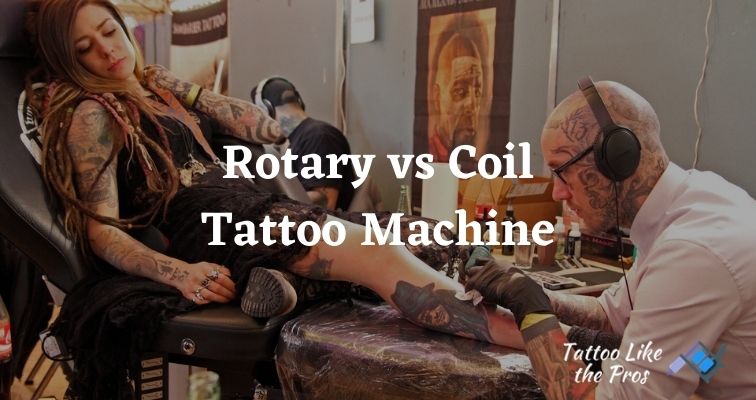Maybe you came across a rotary tattoo machine and wondered what the heck it was? Or maybe you’ve been tattooing awhile now and you want to see how the coil tattoo machine you’ve always used differs from a rotary tattoo machine. Either way, you’ve come to the right place! While they differ dramatically from one another, they both ultimately meet at the same destination–a completed tattoo. Whether you end up using a rotary or coil tattoo machine is going to be up to your personal preference as an artist.
What is a Coil Tattoo Machine?
When you think of a tattoo machine, a coil machine is what comes to mind. A coil tattoo machine uses an electromagnetic current that passes through the coils that cause a draw and release of the tattoo machines armature bar in a hammer-like effect. This hammer-like effect of the armature bar causes the needle to tap into the client’s skin where it, in turn, places the ink in the dermis. A spring then brings the armature bar back up again, which reestablishes the electromagnetic field, where it then passes through the coils again releasing the armature bar again. This cycle is then repeated over and over again.
Coil tattoo machines are more or less the most common choice for most tattoo artists. They are available in a variety of different setups ranging from one to three coils, although, a double coil system is the most common.
What is a Rotary Tattoo Machine?
A rotary tattoo machine operates on totally different scientific principles. It utilizes small electric motors to move the needle up and down–much simpler right? This fluid motion from the electric motor causes the needle to move with a very smooth feel to it.
The rotary machine has evolved in recent years. You can now get them with an armature bar to help increase efficiency–which is a characteristic adapted from coil machines. They also are made available with pneumatic motors, which utilize compressed air instead of electric energy.
Rotary Vs. Coil Tattoo Machine
Weight: Because of the coil machines design utilizing heavy coils help up by iron bars, it is much heavier than the rotary that only requires a small electric engine. Some people prefer the weight of a coil, but if your tattooing all day a lighter weight machine can help ease some of the stress put on your arm.
Noise: Coil machines typically have a loud buzzing noise about them; I’m sure you know the noise if you’ve ever been in a tattoo shop. The constant clicking caused from the hammer-like effect of the armature bar being released makes the coil machines rather loud. While the simpler design of the rotary machine makes for a much quieter machine.
Utility: One of the huge advantages that rotary machines have over a coil machine is that a single machine can be used for both lines and shading. All you need to do is adjust the needle depth with the tube stem vs. with coil machine you need two separate machines: one for shading and one for lines. There is not a coil machine that can be used for both.
Needle Movement: The breaking and reestablishing of the electromagnetic field method used by the coil machines make for much rougher needle movement when compared side by side with the rotary machine that has a constant flow of power creating very smooth needle movements.
It’s best to find which machine adapts to your style, but there is also no rule against using both!
